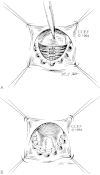Rectovaginal Fistulae
- PMID: 26929752
- PMCID: PMC4755772
- DOI: 10.1055/s-0035-1570393
Rectovaginal Fistulae
Abstract
Rectovaginal fistulae are abnormal epithelialized connections between the rectum and vagina. Fistulae from the anorectal region to the posterior vagina are truly best characterized as anovaginal or very low rectovaginal fistulae. True rectovaginal fistulae are less common and result from inflammatory bowel disease, trauma, or iatrogenic injury. A very few patients are asymptomatic, but the symptoms of rectovaginal fistula are incredibly distressing and unacceptable. Diagnostic approach, timing, and choice of surgical intervention, including sphincteroplasty, gracilis flaps, Martius flaps, and special circumstances are discussed.
Keywords: Martius flap; advancement flap; anovaginal fistula; fistula plug; rectovaginal fistula.
Figures





References
-
- Goldaber K G, Wendel P J, McIntire D D, Wendel G D Jr. Postpartum perineal morbidity after fourth-degree perineal repair. Am J Obstet Gynecol. 1993;168(2):489–493. - PubMed
-
- Homsi R, Daikoku N H, Littlejohn J, Wheeless C R Jr. Episiotomy: risks of dehiscence and rectovaginal fistula. Obstet Gynecol Surv. 1994;49(12):803–808. - PubMed
-
- Wall L L, Karshima J A, Kirschner C, Arrowsmith S D. The obstetric vesicovaginal fistula: characteristics of 899 patients from Jos, Nigeria. Am J Obstet Gynecol. 2004;190(4):1011–1019. - PubMed
-
- Radcliffe A G, Ritchie J K, Hawley P R, Lennard-Jones J E, Northover J M. Anovaginal and rectovaginal fistulas in Crohn's disease. Dis Colon Rectum. 1988;31(2):94–99. - PubMed
-
- Schwartz D, Loftus E, Tremaine W. et al.The natural history of fistulizing Crohn's disease: a population based study. Gastroenterology. 2000;118(4):A337. - PubMed
Publication types
LinkOut - more resources
Full Text Sources
Other Literature Sources

